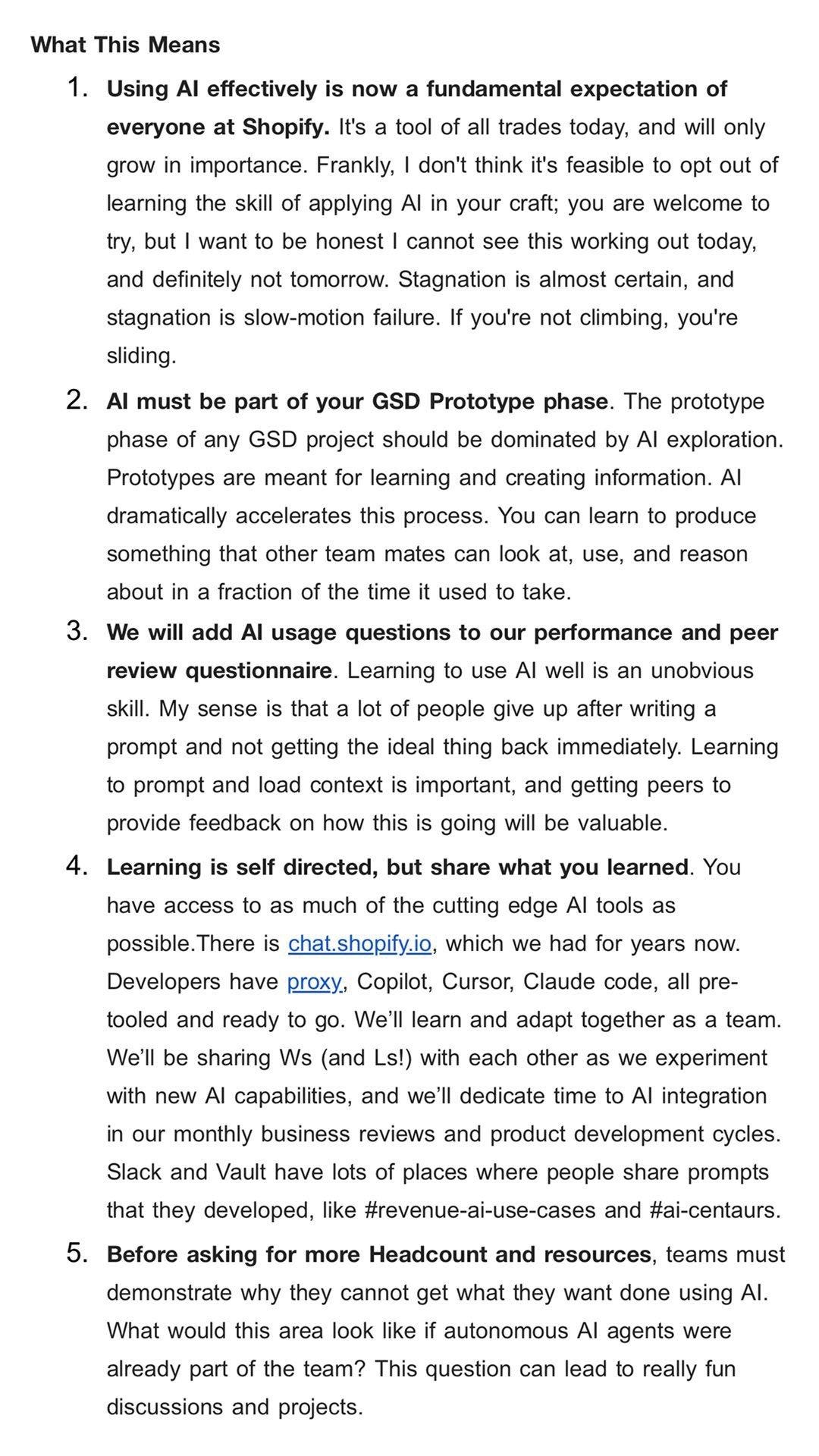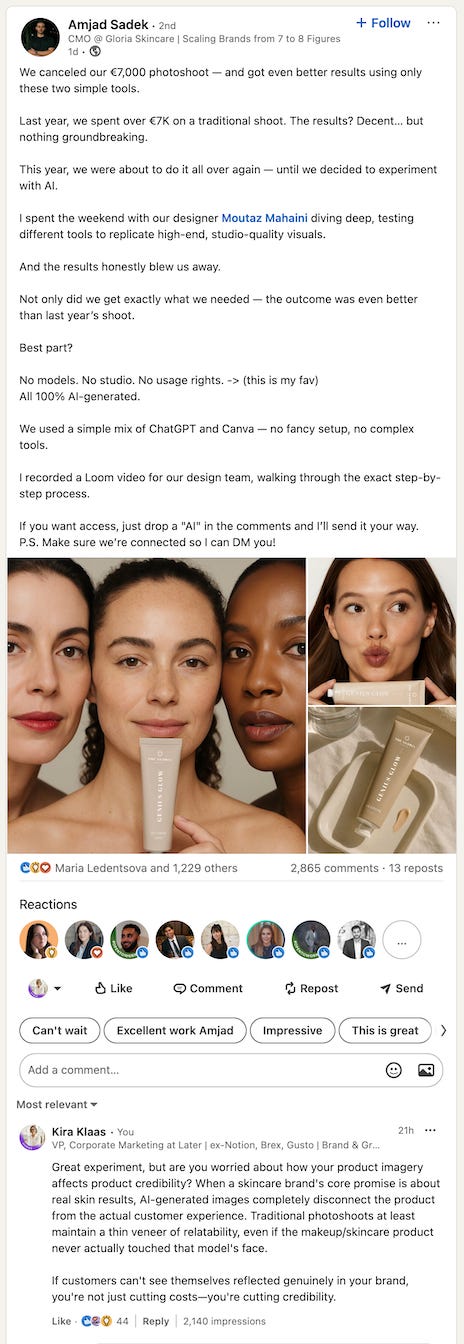When Everyone Has AI, Only Taste Matters
The AI backlash is coming—here's why brands with taste will survive it
LLMs can’t use skincare. And AI models can’t wear clothes. Those are the two realities that really nestled into my brain as I was writing this piece, revisiting some of my earlier thinking on what taste means at work and why I think an AI backlash is inevitable (and of course, what brands should do about it).
We’re also celebrating 3,000 subscribers this week. 🎉 My sincere thanks goes out to each one of you, for being here and supporting my writing!
📌 My next Maven cohort, Brand for Growth-Stage Leaders, opens next week on April 21 (though late enrollments are accepted). As a thank you, subscribers can take $100 off their enrollment.
We’re headed toward an AI backlash. Taste will be the differentiator that separates brands that stay relevant from the ones that fail.
Last summer, I wrote about what taste means at work—how anyone can develop it, and how practicing good taste at work (e.g. demonstrating respect for your audience) drives good business outcomes. Then a few months ago, I broke down the persistently problematic state of AI branding. Today, I want to explore where these themes are going and how they converge.
As “AI-powered” and “generative AI” labels become all the more ubiquitous (and increasingly meaningless), evidence is mounting that customers simply don’t care for them. Recent research from
’s team at Irrational Labs surveying 767 software users found that using “AI” in your messaging doesn’t increase trust, perceived performance, or willingness to pay. In fact, in some cases, it actually lowered performance expectations.We shouldn’t be surprised. Every technological revolution follows a similar pattern: early hype, mass adoption, inevitable backlash, and finally, meaningful integration. We’re rapidly approaching the backlash phase with AI—and when it hits, the brands that have focused on taste rather than tech are the ones who are gonna make it through unscathed.
But you might not know this is coming unless you’re watching the signs.
How to spot the AI backlash early
Look, we’re still at the very tippy-top of the AI iceberg. AI tools are the shittiest they will ever be, right now, when you think about the advancements we can expect even just a few years from now (think about what the internet looked like 30 years ago, or iPhones, 15 years ago). Every CEO is losing their mind to prove how quickly they can “leverage” AI for growth to their investors.
Shopify’s CEO just made AI usage an internal requirement and an official part of performance reviews (and “founder mode” founders are nutting over it):
In a WSJ byline last week, Mark Benioff, the CEO of Salesforce, wrote, “Today’s CEOs are the final generation of executives leading exclusively human workforces. Going forward, we’ll need to learn how to manage human workers and digital labor to work together to deliver efficiency and productivity.” An inspiring vision! ⚰️
And CEOs like Maven’s are having debates like this one all the time—should we “Go all-in on AI: Rebrand Maven as an AI education company. Create focus, nail this niche, become known for it, and expand later” or “Invest heavily in AI while keeping our brand as a broad education company. Capture the AI wave while ensuring people see us as a platform for many skills including growth, product, and leadership”?
Turns out in Gagan’s case he was just rage-baiting us, but it doesn’t change the fact that that this kind of behavior from the top isn’t slowing down.
The AI backlash is coming.
And it will hit hardest for brands that have over-indexed on AI as their primary value proposition.
Beyond the comments sections of all these LinkedIn posts, there are other clear indicators of AI fatigue:
The term “AI-generated” in image captions is now more of a disclaimer than a boast
Increasing consumer skepticism toward AI-centric marketing claims
Growing demand for “proof of reality” (more on this below)—evidence that brands are putting in real effort
Unfortunately, I couldn’t resist chiming in on this post about how this UK beauty brand is using AI to replace photoshoots. I’m sorry, but LLMs can’t use skincare products.
Engagement-bait posts like this are a dime-a-dozen on LinkedIn, and they make it clear who’s diving into the exciting novelty of AI capabilities without stopping to think about their audiences’ wants and needs. Your audience may very well be savvy consumers of AI tools themselves. They know you’re doing it to save time and money. And they can recognize and appreciate when brands invest in quality rather than taking self-serving AI shortcuts.
I loved this quote from
, Strategy Director at U.N.N.A.M.E.D.: “AI [is] symptom of a system built on endless production and efficiency at all costs. AI is just the latest workaround to feed the machine of infinite growth.”Actual user needs haven’t changed!
Tech is notorious for its buzzword cycles. Remember when everything was “mobile-first”? Or “blockchain-enabled”? Or “in the cloud”? Each time, companies rush to adopt the language without necessarily delivering the value, which fatigues customers and turns them into skeptics.
AI is following the same pattern, but at hyperspeed. In just the past year, we’ve watched as:
Basic features get rebranded as “AI-powered” (often with little change to functionality)
Identical interfaces get the ✨ treatment to signal AI presence (here’s my mini history on the ✦ , if you’re curious)
Every product category from email clients to design tools has been flooded with “generative” features
Meanwhile, what we seem to have forgotten is that actual user needs haven’t fundamentally changed. People still want tools that solve their problems efficiently and reliably, and make them look good in front of other people. The “AI” label doesn’t guarantee any of those things—and now we’re really on the brink of it arousing suspicions rather than excitement.
of Link in Bio recently wrote about proof of reality posts becoming a trend in social media marketing. She writes, “It would be easy to say that I think AI is going to be a big trend on brand social in the next year. The reality is, it’s the reaction to AI that will be the even bigger trend. As some brands slopify themselves, it will be the ones that invest even deeper in good creative that will stand out. With this, we’ll see a rise in what I am calling ‘proof of reality’ posts—videos, images, and captions that clarify how specific creative was made.”As AI-generated content becomes indistinguishable from human-made work, brands should shift their content strategies to showcase the craft and human effort behind their posts—tagging the photographer on Instagram, showing the camera operators and makeup artists doing their thing IRL, the handcrafted production process of a product, behind-the-scenes tours, and so on.
This isn’t even a new idea. It’s why that one Dove Beauty commercial (officially titled “The Evolution of Beauty”) was so groundbreaking back in 2006 (know your history, Gen Z).
Taste matters more than technology
Today’s cutting-edge AI feature is tomorrow’s standard offering. Pretty much everything marketers are marketing is a commodity (i.e. you could get some version of the same functionality elsewhere), and tech itself is becoming a commodity faster than ever. When everyone has access to the same technological capabilities, taste becomes the ultimate differentiator.
When I talk about taste in business, I mean the ability to consistently make decisions that demonstrate respect for your audience, show deep empathy for their needs, and deliver aesthetically-pleasing experiences that drive positive business outcomes.
In the context of AI, tasteful use means:
Focusing on outcomes, not technology: Notion doesn’t lead with “the AI workspace.” They emphasize the results: “The assistant that helps you work in the tool where you work.”
Making your customer the main character: Tech should make your customer look good, not threaten to replace them. Google’s “Dear Sydney” Olympics spot was technically impressive but missed the mark in how it inserted AI into the father-daughter relationship.
Knowing when to be invisible: The best AI implementations often disappear into the experience. Spotify’s DJ feature creates a personal connection through AI curation, but doesn’t constantly remind you it’s “powered by AI.” How annoying would that be!
Respecting human creativity: When fashion brands really starting using AI-generated imagery for campaigns back in 2023, consumer backlash was swift. H&M sparked more recent controversy with their plan to create “digital twins” of 30 models for AI-generated imagery. While they argue involving models in the process protects the models’ rights, I can’t help but wonder: how short-lived will that second income stream (for usage rights) be for models?
I’m still hung up on this—how can AI capture the reality of how an exact piece of clothing will lay on a body? Maybe in the future you’ll be able to 3D scan a specific article of clothing in a particular size and then scan a person’s body and then the algorithm will be able to get REALLY exact about the physics of how everything will move and lay and flow. But right now, AI models definitely can’t use skincare. And AI models can’t wear clothes. (So how it looks on the model is now even less likely to be how it looks on you. 🤡)
Marc Bain, author of the BoF article above is right: “When companies have the chance to cut workers or reduce their pay, though, history shows they’ll take it. If part of the appeal of AI for brands is saving money, it’s hard to imagine there won’t be those that see an opportunity to slash the pay they offer.” Pair that with the idea that, in time, people won’t think twice about AI-generated imagery, and it’s a slippery slope we’re already tumbling down at warp speed.
But it’s still worth watching out for how audiences are perceiving these moves, short- and long-term. By choosing to use real talent or not, what do you want to signal to your audience? What’s the message received—is it “innovative” or “cutting corners”?
How to future-proof your brand against the backlash
If you want to position your brand to thrive through the coming AI backlash, this is what I’d do:
1. Show what your tech enables, not what powers it
Lead with benefits, not features. Your customers care about what your product does for them, not how it works. Apple didn’t sell the first iPod as “advanced digital storage technology” but as “1,000 songs in your pocket.”
Instead of “AI-powered productivity,” say “finish weekly reports in half the time,” or instead of “AI-enhanced email,” say “never miss an important message again.” Instead of “AI customer insights platform,” say “predict customer needs before they ask.”
2. Invest in what AI can't (yet) replicate
The most valuable brand assets in an AI-saturated world will be the things algorithms struggle to generate:
Original perspectives, personalities, and voices (like this one 🙋🏼♀️, and many others on Substack)
Surprising creative executions that feel fresh rather than derivative (like the Ghiblification/AI action figure-ing of everything… resist 😑)
Real human connections and communities and especially offline touchpoints
3. Use AI tastefully behind the scenes
The most effective AI implementations often happen behind the scenes. Use AI to ethically enhance your processes and deliver better outcomes, but don’t make it the centerpiece of your customer experience unless it truly transforms that experience. Use it for drafts, outlines, sketches, brainstorms, new directions, and ask it to poke holes in your strategies and analyze their weak points.
When you think of AI as a thinking tool, rather than a writing tool, for example, what you can get out of it gets exponentially more valuable.
4. Cut costs, not credibility
If all you’re using AI for is cutting costs, you very well may be cutting your credibility, too.
If you do use AI in customer-facing ways, be transparent. Explain the value it provides and the human oversight involved. Customers are smart. This demonstrates respect for their intelligence. Show your work, show the process all the same. Prove how you’re using technology as a tool to better serve your customers, not as a replacement for human care and attention (it’s giving “we were too cheap to spend any more time caring about your experience” ✋🏼).
The AI hype cycle will eventually settle, just as every tech wave before it has. When the dust clears, the strongest brands will the ones that maintained their taste and focus on customer needs all the while the AI bandwagon tore through town.
Tech becomes a commodity. Taste becomes a moat. 🫛
Looking for a deeper dive into brand strategy and marketing? Check out my courses on Maven (with 25+ Notion templates, including this one) and Reforge.
📌 On that note—my next Maven cohort, Brand for Growth-Stage Leaders, opens next week on April 21 (though late enrollments are accepted). As a thank you, subscribers can take $100 off their enrollment. Paid subscribers can take $200 off—scroll to the bottom of my last post!
If you liked what you read, consider:
saying hi or dropping a question in the comments!
connecting with me on LinkedIn: 👩🏼💻 Kira Klaas
sending to a friend 💌 or coworker 💬











Build on the Spotify piece here, agree with your take on how they let the experience quietly blend in, but felt like a big reason Wrapped was a miss this past year was because they were too forward with AI being the additive experience (AI DJ/AI podcast) which ended up triggering pushback on social. The best AI comms highlight the value the experience brings to users (like any new feature should!!) vs. leaning into AI as the value prop alone.
Amazing piece, as always! I love how you write. It's like you are putting words to my thoughts! Thank you 💖